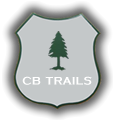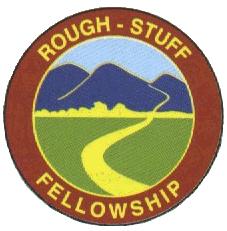Rough Stuff Fellowship
Mountain Biking Before Mountain Bikes
|
|
Mountain Biking Before Mountain Bikes
by Steve Griffith: Chairman of the Rough Stuff Fellowship
"Off road cycling... you mean mountain biking... everyone knows about that invented by the Americans in California in the 70's. Riders in bright coloured lycra speeding along tracks on bikes most VCC members wouldn't be seen dead on!!!"
The above is of course an extreme stereotype, nevertheless there is a widespread perception that off road cycling is a comparatively recently pastime and can only be done on a specialist i.e. mountain bike. This article attempts to outline the history of off road cycling and will demonstrate it has been an intrinsic part of cycling ever since the invention of the bicycle. A crucial point is that it can and has been done on almost any bike.
Defining terms: Until the 1980's off road riding was know as rough stuff or pass storming. The origin of the former is in opposition to smooth stuff (ie tarmac). Over the years there has been much debate amongst adherents of this type of cycling as to a definition. To my mind the simplest is perhaps the best:
"Rough stuff begins where the tarmac ends"
Or perhaps as put by Tim Hughes editor of the CTC magazine Cycletouring writing in the 1980's:
"To the dedicated rough stuffer there is no such thing as a dead end"
So what is the origin of rough stuff cycling? In the early days of cycling there were very few metalled roads so by default virtually all cycling could be defined as rough stuff. In this article I want to explore the practice of by choice leaving the road to ride push or carry a cycle over bridleways, footpaths and tracks (or even where there is no path).
The earliest record of anyone doing this goes back to 1890 when one Amos Sugden reported in the CTC Gazette that he had taken his bicycle weighing 50lbs over Sty Head Pass (which runs through the heart of the Lake District from Wasdale Head to Seathwaite). At the time this caused quite stir in the cycling world but it is clear from the response that he was not the only one to use a cycle in this way.
A regular contributor to 'Cycling' from 1905 to 1925 was Vernon Blake who is now best known for adopting and developing many of Velocio's ideas on gearing. This part of his life is explored in more depth in Frank Berto's The Dancing Chain (1). Writing before WW1 he describes crossing Black Sail and other major Lake District passes. He was clearly a rider of great ability as he often describes what took him a day a route that would take an average rider two days.
The cycling writer who had the most influence on the growth of rough stuff was W M Robinson (1877-1956) who wrote under the pseudonym 'Wayfarer'. In both his writing and lantern lectures he advocated leaving the tarmac to explore the wilder ways. To Wayfarer beyond the roads end there laid a wonderful world, which he urged the cyclist to seek out. To put this into context Wayfarer was a member of the cycling establishment with huge influence.
When the Rough Stuff Fellowship (RSF) was founded in 1955 one of their first acts was to arrange for a memorial to him at the apex of the Nant Rhyd Wilym crossing in the Berwyns, North Wales This was a most fitting place as his most influential rough stuff article was an account of this crossing 1919 (2) entitled Over the Top (fig 1). This was done in March of that year through heavy snow, which of course added to the adventure. Contemporary readers would have recognised the military significance of the title. To many CTC and RSF cyclists the crossing has become known as 'The Wayfarer' and despite the partial tarmacing of the route is still very much a must do. It can be done easily in three to four hours, west to east being slightly easier.
Writing an appreciation of Wayfarer in 1957 Bill Oakley (later CTC President) stated that Robinson had been introduced to rough stuff by W.P. Cook and other members of the Anfield Bicycle Club. Oakley described as one of the main reasons for the popularity of rough stuff in the 1920's was the many young men returning from war disappointed with the humdrum daily existence and keen to seek out new adventures and what better than pass storming. After the inspiration of Over the Top there was a great desire to seek out even greater challenges:
"So nothing but the highest track over the Berwyns would do, Moel Sych"... meanwhile the Scots were storming the Grampians by the exhausting Larig Ghru. Stanley Baron (journalist who wrote for the News Chronicle) wrote memorably about the Corrieyarrack Pass a derelict military road rising to 2507ft... Kuklos wrote and lectured about "Wildest Britain", the far north west of Scotland (3)
At the end of the article Oakley makes the point that Wayfarers rough riding only made up a fraction of his cycling. The majority was on the highways and byways of Britain.
Often Wayfarer's comments in his weekly column stirred up a string of letters with writers both pro and anti. One example I came across was in Cycling 6th January 1928 when he stated that the cyclist could see and explore as much as a walker. One extreme response was to suggest that cyclist who pass stormed were mentally ill. A rough stuff enthusiast issued a challenge that within 200 miles of Leicester there was nowhere he could not take a bike. A number of other responses indicate just how much rough riding was a normal part of cycle touring:
"I would like to state that the Oldham CTC has traversed with their machines a number of Bartholomew's dotted lines in the Peak District. In one day Doctor's Gate, the Snake-Hatfield Pass, Jacob's Ladder and Chapel Gate were crossed. By taking machines along paths such as these an entirely new field of activity is open up to the keen cyclist who prefers the bracing air and solitudes of the heathery moorlands to the petrol reeking and discordant bustle of motor infested highways."
G Hewitt 2nd March 1928
"I took my cycle a Raleigh weighing over 45 lbs over Sty Head Pass... and have nothing but pleasant recollections of the crossing. Such rides are not merely done for accomplishment; the cyclist takes them in the course of his tour as they come, and they merely serve to add zest to his tour".
A J F Field 2nd March 1928
Writing a week later (9th March 1928) about a crossing in the Peak District in November a CTC member recalled:
"We enjoyed this cycle ramble despite the fact there was short snow storm … several ramblers we met said it was impossible to complete the journey. The impossible was achieved, and as light was rapidly fading, a further ramble over Jacobs Ladder was abandoned in favour of tea."
Interest in rough stuff was not just restricted to the CTC. A number of racing clubs would feature a time trial in their programme taking in off road riding. Nationally known was the Balham CC Rough Riders 25, an early season event held in February or March centred on Westerham and Biggin Hill (Kent/Surrey border). During the interwar years it attached many top riders. Time was slow typically the winner doing around 1:44, understandable in view of the terrain.
With this long interest in off road cycling it is perhaps surprising that the RSF was not founded until 1955. The catalyst was an article in The Bicycle in 1954 (4) entitled 'Are the Rough Ways Losing their Popularity'. A letter in response by W H Paul that suggested the formation of a Rough Stuff Fellowship (fig 2). With an inaugural meeting in Leominster the club grew steadily to over 250 members by May 1957. Later in that year the Wayfarer memorial was unveiled (fig 3). A tradition that continues to this day is for passers-by to record their name in a notebook kept in a tin box at the foot of the memorial. The memorial was vandalised in the late 60's and was replaced. An omission in my view is that the inscription does not mention Wayfarer was a cyclist and it does not explain what the initials RSF stand for.
The RSF has, since its inception, always held an Easter Meet in various locations (usually Wales or Northern England). This features many of the best traditions of British club life; a photography competition, annual dinner, AGM and of course rides lead by someone with local knowledge. The RSF has continued to produce a bi- monthly magazine The Rough Stuff Journal which contains a great deal of route information and reports on the doings of local groups. The RSF also holds an unrivalled library of information on routes compiled from members' experiences.
It may surprise members of the VCC but many RSF members have little or no interest in the technical side of cycling. They would be unable to tell you the make of components on their bikes. Indeed for many years Archie Woodward the RSJ editor (1969 to 1991) would refuse to publish any thing on equipment saying it was outside the scope of the magazine.
My research indicates in the early years of the RSF the gearing of choice was a Sturmey. Often this was the FM or an AW geared so that the top was used as normal to give lower gears. Recently the 14 speed Rolhoff hub gear has been seen on a number of RSF rides. The benefit of the hub gear to the rough stuffer is simply an enclosed mechanism not likely to be damaged on tracks plus the ability to change down standing still. The other gear of choice in early years was the Standard Cyclo favoured for the huge range and durability. Sometimes used as part of a hybrid set up with a Sturmey. The fixed wheel had it adherents but one problem that has been pointed out is the tendency for the pedal to dig in the riders shin when wheeling the bike (a frequent occurrence on the rough!). Wayfarer himself was an advocate of the dictum:
"As little bike as possible"
This meant a fixed wheel (in his case usually a 63" or 57") single brake and no unnecessary accessories.
Many RSF pioneers continued to use steel components even after alloy became affordable this was in the belief alloy was simply not up to the wear and tear of off road riding. A recurring feature of articles is the ingenuity shown when faced with a mechanical breakdown miles from anywhere. My favourites include :
1. Using braces to tension a slipping dynamo
2. In an article entitled 37 Miles on a Baked Bean Can, a cracked down tube is held together with jubilee clips around the can.
3. Broken carrier: fashioned a saddlebag support from a flat piece of wood wedged against the seat tube and resting on the rear brake bridge.
4. Using a postage stamp to mend a puncture after discovering the repair kit had been left at home.
Other components that found favour were Mafac Cantilevers: great stoppers and the added benefit of very little metal to get clogged up with mud. Stronglight 49D cranks and TA rings; enabling very low gears and Dunlop rims and tyres.
Although the RSF has a very distinctive badge (see fig 4), it has been suggested that due to their widespread use a cotton duck saddlebag (often a Carradice Camper long flap) is de-facto a badge.
Over the last 40 years off road riding has gradually ceased to be part of normal club riding and has now become a specialist part of cycling. Partly this has been driven by changes in equipment. Until the 1950's the majority of cyclist only had one machine, which they used for touring and racing alike. As bicycles became more specialised they ceased to be so versatile. A bike with no mudguards with narrow tyres and steep angles is only going to be a liability off road. Many of today's club cyclist will either not go off road or would want to use a mountain bike. It is interesting to note that today within the RSF about half are on mountain bikes the rest riding traditional touring machines.
Evidence of how much rough stuff was viewed as an integral part of the experience for the touring cyclist can be found in the format of the BCTC (British Cycle Tourist Competition). Run by the CTC and inaugurated in 1952 until the late 80's its aim was to find Britain's best tourist. Rough stuff riding was a key element and the organisers often went to great lengths to find awkward tracks, fords etc that would test a rider's skill. For some competitors, even winners, it was the part they complained about the most. Audrey Hughes, frequent winner of the Ladies Cup recalled in a speech to the Pedal Club in 1967:
"The Rough Stuff is insane made more for an acrobat, and you need to have no respect for your bike to do it. Four fords in the 63 final, an organisers built bridge and a stretch through the centre of a hedge in 64" (5)
It is clear from researching this article that there is a complete difference of approach and philosophy between the traditional pass stormer and the mountain biker. The latter wants to be able to ride all the time and will avoid routes where this is not possible. To the former walking is an integral part of the experience and none of the blue riband crossing listed above could be done without some walking. Perhaps a leading RSF member, Bob Harrison, best sums up this attitude:
"I never go for a walk without my bike"
It is not the purpose of this article to describe the origins and growth of Mountain Biking. Rather, I have sought to illustrate the long history of off road cycling and its central role in club cycling. It is only in the last 40 years that off road cycling has ceased to be part of the mainstream of touring and racing clubs. This change has been driven by two factors: increasing affluence, which meant many cyclists, could afford different types of cycle and specialist development in cycle and component design which meant that one size could no longer fit all. Perhaps there is a third reason the extreme dislike felt by many cyclists to getting their bikes covered in mud!
FOOTNOTES:
1. Frank Berto: The Dancing Chain 2004 2nd Edition pp61-64
2. Cycling 8th May 1919
3. Cycling 13th June 1957 pp483-484
4. The Bicycle 13th October 1954 by Winova pp6-8
5. Cycling 21st October 1967
REFERENCES:
www.rsf.org.uk has some of this history of the RSF but even more useful are back issues of the Rough Stuff Journal published continuously since 1955. Also a booklet for sale: RSF the Early Years by H.S. Williams
The Birth of Dirt: Frank Berto ,outlines the development of mountain biking
William Oakley: Winged Wheels. The history of the CTC 1978
Harry RG Inglis : Hill Path Contours a guide too many of the classic off road routes of Scotland. Numerous editions from c1910 to 1976 (see fig 6)
Tim Hughes: Adventure Cycling , Blandford 1977 pp180-184 useful list of rough stuff tracks. Main criteria routes must not involve much carrying of cycle.
|
|

 Crested Butte History
Crested Butte History 













